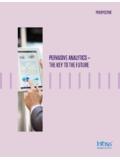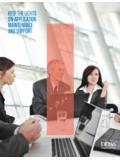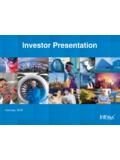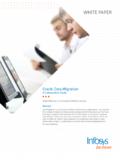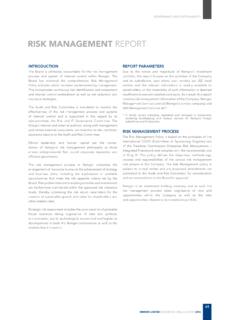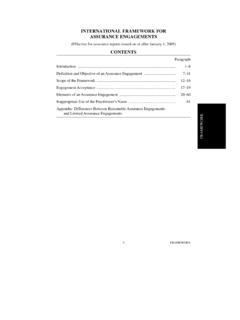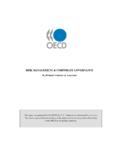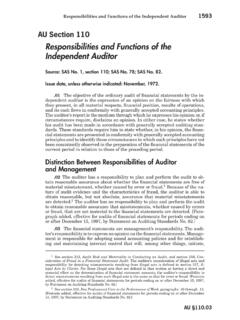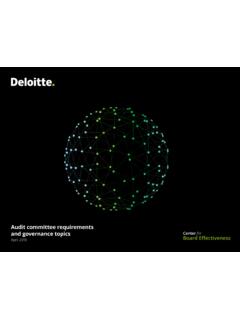Transcription of INDEPENDENT AUDITOR’S REPORT - Infosys
1 INDEPENDENT AUDITOR S REPORT TO THE MEMBERS OF Infosys limited REPORT on the Audit of the Consolidated Financial Statements Opinion We have audited the accompanying consolidated financial statements of Infosys limited (the Company ) and its subsidiaries (the Company and its subsidiaries together referred to as the Group ) which comprise the Consolidated Balance Sheet as at March 31, 2021, and the Consolidated Statement of Profit and Loss (including Other Comprehensive Income), the Consolidated Statement of Changes in Equity and the Consolidated Statement of Cash Flows for the year then ended, and a summary of significant accounting policies and other explanatory information (hereinafter referred to as the consolidated financial statements ).
2 In our opinion and to the best of our information and according to the explanations given to us, the aforesaid consolidated financial statements, give the information required by the Companies Act, 2013 (the Act ) in the manner so required and give a true and fair view in conformity with the Indian Accounting Standards prescribed under section 133 of the Act read with the Companies (Indian Accounting Standards) Rules, 2015, as amended ( Ind AS ) and other accounting principles generally accepted in India, of the consolidated state of affairs of the Group as at March 31, 2021 and their consolidated profit, their consolidated total comprehensive income, their consolidated changes in equity and their consolidated cash flows for the year ended on that date.
3 Basis for Opinion We conducted our audit of the consolidated financial statements in accordance with the Standards on Auditing ( SA s) specified under section 143(10) of the Act. Our responsibilities under those Standards are further described in the Auditor s Responsibilities for the Audit of the Consolidated Financial Statements section of our REPORT . We are INDEPENDENT of the Group in accordance with the Code of Ethics issued by the Institute of Chartered Accountants of India ( ICAI ) together with the ethical requirements that are relevant to our audit of the consolidated financial statements under the provisions of the Act and the Rules made thereunder, and we have fulfilled our other ethical responsibilities in accordance with these requirements and the ICAI s Code of Ethics.
4 We believe that the audit evidence obtained by us is sufficient and appropriate to provide a basis for our audit opinion on the consolidated financial statements. Key Audit Matters Key audit matters are those matters that, in our professional judgment, were of most significance in our audit of the consolidated financial statements of the current period. These matters were addressed in the context of our audit of the consolidated financial statements as a whole, and in forming our opinion thereon, and we do not provide a separate opinion on these matters.
5 We have determined the matters described below to be the key audit matters to be communicated in our REPORT . Sr. No. Key Audit Matter Auditor s Response 1 Revenue recognition Principal Audit Procedures Performed The Group s contracts with customers include contracts with multiple products and services. The group derives revenues from IT services comprising software development and related services, maintenance, consulting and package implementation, licensing of software products and platforms across the Group s core and digital offerings and business process management services.
6 The Group assesses the services promised in a contract and identifies distinct performance obligations in the contract. Identification of distinct performance obligations to determine the deliverables and the ability of the customer to benefit independently from such deliverables involves significant judgement. In certain integrated services arrangements, contracts with customers include subcontractor services or third-party vendor equipment or software. In these types of arrangements, revenue from sales of third-party vendor products or services is recorded net of costs when the Group is acting as an agent between the customer and the vendor, and gross when the Group is the principal for the transaction.
7 In doing so, the Group first evaluates whether it controls the products or service before it is transferred to the customer. The Group considers whether it has the primary obligation to fulfil the contract, inventory risk, pricing discretion and other factors to determine whether it controls the products or service and therefore, is acting as a principal or an agent. Fixed price maintenance revenue is recognized ratably either on (1) a straight-line basis when services are performed through an indefinite number of repetitive acts over a specified period or (2) using a percentage of completion method when the pattern of benefits from the services rendered to the customer and the Group s costs to fulfil the contract is not even through the period of contract because the services are generally discrete in nature and not repetitive.
8 The use of method to recognize the maintenance revenues requires judgment Our audit procedures related to the (1) identification of distinct performance obligations, (2) determination of whether the Group is acting as a principal or agent and (3) whether fixed price maintenance revenue is recognized on a straight-line basis or using the percentage of completion method included the following, among others: We tested the effectiveness of controls relating to the (a) identification of distinct performance obligations, (b) determination of whether the Group is acting as a principal or an agent and (c) determination of whether fixed price maintenance revenue for certain contracts is recognized on a straight-line basis or using the percentage of completion method.
9 We selected a sample of contracts with customers and performed the following procedures: Obtained and read contract documents for each selection, including master service agreements, and other documents that were part of the agreement. Identified significant terms and deliverables in the contract to assess management s conclusions regarding the (i) identification of distinct performance obligations (ii) whether the Group is acting as a principal or an agent and (iii) whether fixed price maintenance revenue is recognized on a straight-line basis or using the percentage of completion method Sr.
10 No. Key Audit Matter Auditor s Response and is based on the promises in the contract and nature of the deliverables. As certain contracts with customers involve management s judgment in (1) identifying distinct performance obligations, (2) determining whether the Group is acting as a principal or an agent and (3) whether fixed price maintenance revenue is recognized on a straight-line basis or using the percentage of completion method, revenue recognition from these judgments were identified as a key audit matter and required a higher extent of audit effort.
